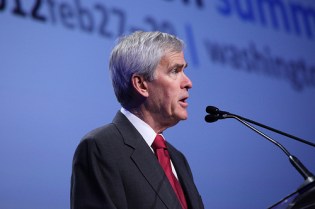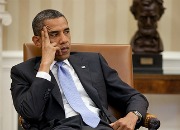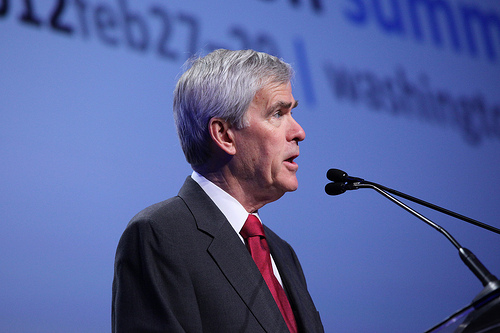
Sen. Jeff Bingaman. (Photo by Senator Chris Coons.)
Sen. Jeff Bingaman (D-N.M.), the soon-to-retire chair of the Senate Energy and Natural Resources Committee, released his long-awaited proposal for a Clean Energy Standard (CES) today. Here’s a two-page summary [PDF].
First thing to note: It’s not going to pass. There is no way Republicans are going to allow Obama a policy victory during an election year. So this bill is just a marker, like a message in a bottle to be discovered by some future, sane Congress. It’s hard to get too worked up about it.
That said, it looks pretty good to me. Obviously I would prefer … oh, all sorts of other policies. A price on carbon. Feed-in tariffs. Coherent innovation policy and funding. A renewable energy standard. But as a kind of middle-of-the-road policy that is safe, at least on the merits, from the most common conservative attacks, it’s fine.
The idea is to get 80 percent of U.S. electricity from “low- or no-carbon sources” by 2035. (Unlike an RES, the CES would allow natural gas and coal with CCS to qualify.) To that end, utilities selling on the retail market would have to generate a greater percentage of clean energy each year. But only the biggest utilities: “In 2015, only 8% of all utilities would need to meet the standard, and in 2025 only 13% of all utilities would need to meet it.” Most municipal utilities and co-ops would be exempt. Affected utilities would be issued credits based on the carbon intensity of their sources. If they get excess credits for lowering carbon more than is mandated, they can trade them for dough — thus a constant incentive to get cleaner.
Bingaman asked the U.S. Energy Information Administration to model the effects of a well-designed (as opposed to poorly designed) CES. The EIA found that “the CES could reduce emissions in the power sector by nearly 20 percent compared to a business-as-usual scenario in 2025 and by 40 percent in 2035” and that “the policy will have little to no effect on nationally averaged electricity rates over the first decade of the program.” I’m sure conservatives will accept those findings and refrain from baseless attacks.
A couple elements are especially worth calling out and celebrating.
First, it’s notable that the CES doesn’t cost the federal government anything, nor does it raise any money for the federal government. It’s budget neutral. So the “tax!!1!” attack won’t get anywhere. However, utilities who find themselves short on credits can pay an “Alternative Compliance Payment.” What happens to that money? “The funds from those payments are directed back to the State from which they originated to fund State energy efficiency programs.” The money stays in the state and helps reduce ratepayers’ exposure to higher energy prices. It’s a clever idea, drawn from a Center for American Progress white paper.
Second, this:
Combined Heat and Power (CHP) units generate electricity and also use the heat generated for various purposes. The efficiency of these units is incentivized under the CES by crediting them as a clean resource.
As Sean Casten has been at such pains to tell us, capturing and exploiting waste heat is a potentially enormous source of low-carbon energy. It’s about time policymakers incorporated it into their clean-energy plans.
Anyway, there you have it: another good idea that will go nowhere. I remember when the initial Waxman-Markey bill was seen as a huge step down from adequate climate legislation. Then the Senate version was a huge step down from Waxman-Markey. Then the RES was a huge step down from the Senate bill. Now a CES is a huge step down from the RES. As many steps as we’ve taken down, as far as our ambition has curdled and shrunk, still conservative intransigence blocks all action. And so we slide farther and farther behind, less and less prepared for the century ahead.



